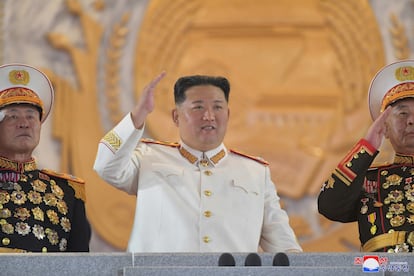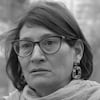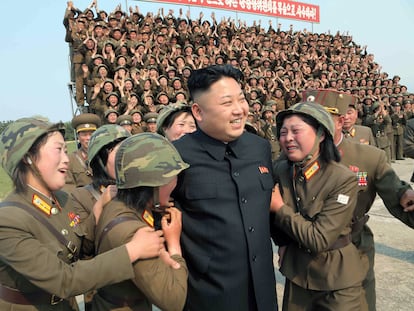Kim Jong-un vows to step up development of North Korea’s nuclear program
Pyongyang displays its largest intercontinental missile, the Hwasong-17, in a night military parade to celebrate the anniversary of its armed forces


Kim Jong-un likes military parades. In the last two years since the pandemic began, the North Korean leader has held four, all of them at night, as many as in his first five years in office, to show off the latest additions to his atomic and ballistic arsenal. And he has taken advantage of the last one to send an unequivocal message: he has issued orders to reinforce his country’s nuclear program. The forces of the republic must be fully prepared to fulfill their mission and their deterrence task at any time, he stressed in his speech.
The parade to commemorate the 90th anniversary of the founding of the North Korean armed forces was held on Sunday night, although North Korean television did not broadcast it until late on Monday. Pyongyang did not hold back on its display of might. It exhibited all its new additions in ballistics. There were submarine-launched missiles (SLBMs), tactical missiles, multiple rocket launchers (MRLs), and also the hypersonic missiles that Kim himself had announced in January of last year, and that were tested for the first time in September, according to the regime. But the star of the parade was the largest intercontinental missile developed by the North Korean army, the Hwasong-17. Three of them were paraded on their transportation and launch vehicles to mark the end of the event, between bursts of fireworks.
North Korea claims to have successfully tested this projectile, which it had already shown in a previous parade in March of last year. But analysts consider that the launch of that rocket, nicknamed “the monster” by international experts due to its gigantic dimensions, was a failure as the missile exploded shortly after taking off on March 16. A second launch on March 25, which Pyongyang claimed was a Hwasong-17, did hit its targets, but analysts believe that what was tested that day was an earlier ICBM model, a slightly modified Hwasong-15.
Kim, accompanied by his wife Ri Sol-ju, showed up at the parade in a white marshal’s uniform — the title by which his fellow citizens often refer to him — instead of the civilian suits he has worn on previous occasions.
Cries of “long life” among the crowd
As usual in his public appearances, or at least in those that are broadcast by the state media, he was received with delirious shouts of “manse! manse!” (“long live”) by the crowds that filled Kim Il-sung Square. According to the shots of the crowd shown on North Korean television, no one was wearing a mask.
In his speech, the supreme leader - who does not necessarily speak in public whenever he attends a parade - assured that “we will continue to take measures to further strengthen and develop nuclear-armed forces, which our country possesses, at the fastest possible speed.”
Kim assured that the main mission of his nuclear weapons is to deter other countries from starting a war. He did not mention the United States or South Korea, the nations that Pyongyang considers its greatest enemies. But he did issue a warning: “Our nuclear-armed forces will have no choice but to carry out their second mission if any force attempts to infringe upon the fundamental interests of our country.” The supreme leader did not provide details of what this second task might be, presumably an attack.
The words of the third member of the Kim dynasty in North Korea were uttered as South Korean prepared for a new government under the conservative Yoon Suk-yeol, who won the presidential elections last March. The former attorney general has promised a tougher policy against Pyongyang, in contrast to the approach maintained by the outgoing head of state, Moon Jae-in, during his five years in office and which opened the door to the start of negotiations on nuclear disarmament. between Kim and then-US president Donald Trump.
The failure of these negotiations, embodied in the fiasco at the Hanoi summit between the two leaders in February 2019, led Kim to resume the weapons program that he had put on hold during the dialogue process. So far this year, North Korea has carried out a dozen missile tests, including an ICBM in March, and analysts fear it may be preparing a nuclear test as well.
Tu suscripción se está usando en otro dispositivo
¿Quieres añadir otro usuario a tu suscripción?
Si continúas leyendo en este dispositivo, no se podrá leer en el otro.
FlechaTu suscripción se está usando en otro dispositivo y solo puedes acceder a EL PAÍS desde un dispositivo a la vez.
Si quieres compartir tu cuenta, cambia tu suscripción a la modalidad Premium, así podrás añadir otro usuario. Cada uno accederá con su propia cuenta de email, lo que os permitirá personalizar vuestra experiencia en EL PAÍS.
¿Tienes una suscripción de empresa? Accede aquí para contratar más cuentas.
En el caso de no saber quién está usando tu cuenta, te recomendamos cambiar tu contraseña aquí.
Si decides continuar compartiendo tu cuenta, este mensaje se mostrará en tu dispositivo y en el de la otra persona que está usando tu cuenta de forma indefinida, afectando a tu experiencia de lectura. Puedes consultar aquí los términos y condiciones de la suscripción digital.
More information
Últimas noticias
The complicated life of Francesca Albanese: A rising figure in Italy but barred from every bank by Trump’s sanctions
Reinhard Genzel, Nobel laureate in physics: ‘One-minute videos will never give you the truth’
Pinochet’s victims grapple with José Antonio Kast’s rise in Chile
Half of Scotland is in the hands of 420 property owners
Most viewed
- Pablo Escobar’s hippos: A serious environmental problem, 40 years on
- Why we lost the habit of sleeping in two segments and how that changed our sense of time
- Trump’s obsession with putting his name on everything is unprecedented in the United States
- Charles Dubouloz, mountaineering star, retires at 36 with a farewell tour inspired by Walter Bonatti
- The Florida Keys tourist paradise is besieged by immigration agents: ‘We’ve never seen anything like this’










































